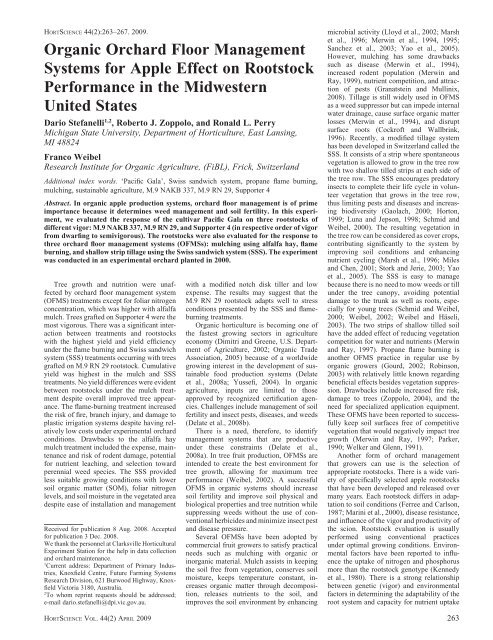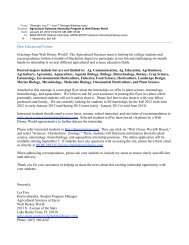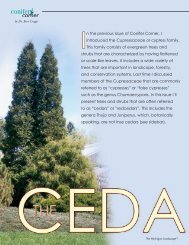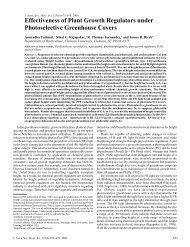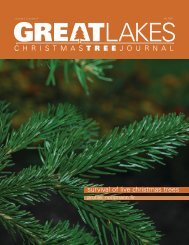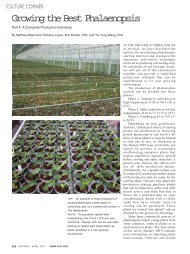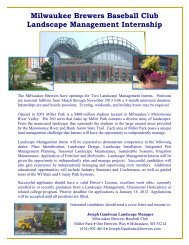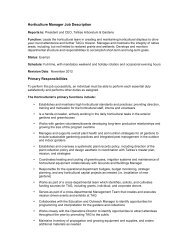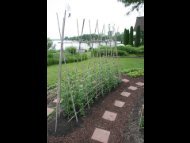Dario Stefanelli - HortScience
Dario Stefanelli - HortScience
Dario Stefanelli - HortScience
You also want an ePaper? Increase the reach of your titles
YUMPU automatically turns print PDFs into web optimized ePapers that Google loves.
HORTSCIENCE 44(2):263–267. 2009.<br />
Organic Orchard Floor Management<br />
Systems for Apple Effect on Rootstock<br />
Performance in the Midwestern<br />
United States<br />
<strong>Dario</strong> <strong>Stefanelli</strong> 1,2 , Roberto J. Zoppolo, and Ronald L. Perry<br />
Michigan State University, Department of Horticulture, East Lansing,<br />
MI 48824<br />
Franco Weibel<br />
Research Institute for Organic Agriculture, (FiBL), Frick, Switzerland<br />
Additional index words. ‘Pacific Gala’, Swiss sandwich system, propane flame burning,<br />
mulching, sustainable agriculture, M.9 NAKB 337, M.9 RN 29, Supporter 4<br />
Abstract. In organic apple production systems, orchard floor management is of prime<br />
importance because it determines weed management and soil fertility. In this experiment,<br />
we evaluated the response of the cultivar Pacific Gala on three rootstocks of<br />
different vigor: M.9 NAKB 337, M.9 RN 29, and Supporter 4 (in respective order of vigor<br />
from dwarfing to semivigorous). The rootstocks were also evaluated for the response to<br />
three orchard floor management systems (OFMSs): mulching using alfalfa hay, flame<br />
burning, and shallow strip tillage using the Swiss sandwich system (SSS). The experiment<br />
was conducted in an experimental orchard planted in 2000.<br />
Tree growth and nutrition were unaffected<br />
by orchard floor management system<br />
(OFMS) treatments except for foliar nitrogen<br />
concentration, which was higher with alfalfa<br />
mulch. Trees grafted on Supporter 4 were the<br />
most vigorous. There was a significant interaction<br />
between treatments and rootstocks<br />
with the highest yield and yield efficiency<br />
under the flame burning and Swiss sandwich<br />
system (SSS) treatments occurring with trees<br />
grafted on M.9 RN 29 rootstock. Cumulative<br />
yield was highest in the mulch and SSS<br />
treatments. No yield differences were evident<br />
between rootstocks under the mulch treatment<br />
despite overall improved tree appearance.<br />
The flame-burning treatment increased<br />
the risk of fire, branch injury, and damage to<br />
plastic irrigation systems despite having relatively<br />
low costs under experimental orchard<br />
conditions. Drawbacks to the alfalfa hay<br />
mulch treatment included the expense, maintenance<br />
and risk of rodent damage, potential<br />
for nutrient leaching, and selection toward<br />
perennial weed species. The SSS provided<br />
less suitable growing conditions with lower<br />
soil organic matter (SOM), foliar nitrogen<br />
levels, and soil moisture in the vegetated area<br />
despite ease of installation and management<br />
Received for publication 8 Aug. 2008. Accepted<br />
for publication 3 Dec. 2008.<br />
We thank the personnel at Clarksville Horticultural<br />
Experiment Station for the help in data collection<br />
and orchard maintenance.<br />
1<br />
Current address: Department of Primary Industries,<br />
Knoxfield Centre, Future Farming Systems<br />
Research Division, 621 Burwood Highway, Knoxfield<br />
Victoria 3180, Australia.<br />
2<br />
To whom reprint requests should be addressed;<br />
e-mail dario.stefanelli@dpi.vic.gov.au.<br />
with a modified notch disk tiller and low<br />
expense. The results may suggest that the<br />
M.9 RN 29 rootstock adapts well to stress<br />
conditions presented by the SSS and flameburning<br />
treatments.<br />
Organic horticulture is becoming one of<br />
the fastest growing sectors in agriculture<br />
economy (Dimitri and Greene, U.S. Department<br />
of Agriculture, 2002; Organic Trade<br />
Association, 2005) because of a worldwide<br />
growing interest in the development of sustainable<br />
food production systems (Delate<br />
et al., 2008a; Yussefi, 2004). In organic<br />
agriculture, inputs are limited to those<br />
approved by recognized certification agencies.<br />
Challenges include management of soil<br />
fertility and insect pests, diseases, and weeds<br />
(Delate et al., 2008b).<br />
There is a need, therefore, to identify<br />
management systems that are productive<br />
under these constraints (Delate et al.,<br />
2008a). In tree fruit production, OFMSs are<br />
intended to create the best environment for<br />
tree growth, allowing for maximum tree<br />
performance (Weibel, 2002). A successful<br />
OFMS in organic systems should increase<br />
soil fertility and improve soil physical and<br />
biological properties and tree nutrition while<br />
suppressing weeds without the use of conventional<br />
herbicides and minimize insect pest<br />
and disease pressure.<br />
Several OFMSs have been adopted by<br />
commercial fruit growers to satisfy practical<br />
needs such as mulching with organic or<br />
inorganic material. Mulch assists in keeping<br />
the soil free from vegetation, conserves soil<br />
moisture, keeps temperature constant, increases<br />
organic matter through decomposition,<br />
releases nutrients to the soil, and<br />
improves the soil environment by enhancing<br />
microbial activity (Lloyd et al., 2002; Marsh<br />
et al., 1996; Merwin et al., 1994, 1995;<br />
Sanchez et al., 2003; Yao et al., 2005).<br />
However, mulching has some drawbacks<br />
such as disease (Merwin et al., 1994),<br />
increased rodent population (Merwin and<br />
Ray, 1999), nutrient competition, and attraction<br />
of pests (Granatstein and Mullinix,<br />
2008). Tillage is still widely used in OFMS<br />
as a weed suppressor but can impede internal<br />
water drainage, cause surface organic matter<br />
losses (Merwin et al., 1994), and disrupt<br />
surface roots (Cockroft and Wallbrink,<br />
1996). Recently, a modified tillage system<br />
has been developed in Switzerland called the<br />
SSS. It consists of a strip where spontaneous<br />
vegetation is allowed to grow in the tree row<br />
with two shallow tilled strips at each side of<br />
the tree row. The SSS encourages predatory<br />
insects to complete their life cycle in volunteer<br />
vegetation that grows in the tree row,<br />
thus limiting pests and diseases and increasing<br />
biodiversity (Gaolach, 2000; Horton,<br />
1999; Luna and Jepson, 1998; Schmid and<br />
Weibel, 2000). The resulting vegetation in<br />
the tree row can be considered as cover crops,<br />
contributing significantly to the system by<br />
improving soil conditions and enhancing<br />
nutrient cycling (Marsh et al., 1996; Miles<br />
and Chen, 2001; Stork and Jerie, 2003; Yao<br />
et al., 2005). The SSS is easy to manage<br />
because there is no need to mow weeds or till<br />
under the tree canopy, avoiding potential<br />
damage to the trunk as well as roots, especially<br />
for young trees (Schmid and Weibel,<br />
2000; Weibel, 2002; Weibel and Häseli,<br />
2003). The two strips of shallow tilled soil<br />
have the added effect of reducing vegetation<br />
competition for water and nutrients (Merwin<br />
and Ray, 1997). Propane flame burning is<br />
another OFMS practice in regular use by<br />
organic growers (Gourd, 2002; Robinson,<br />
2003) with relatively little known regarding<br />
beneficial effects besides vegetation suppression.<br />
Drawbacks include increased fire risk,<br />
damage to trees (Zoppolo, 2004), and the<br />
need for specialized application equipment.<br />
These OFMS have been reported to successfully<br />
keep soil surfaces free of competitive<br />
vegetation that would negatively impact tree<br />
growth (Merwin and Ray, 1997; Parker,<br />
1990; Welker and Glenn, 1991).<br />
Another form of orchard management<br />
that growers can use is the selection of<br />
appropriate rootstocks. There is a wide variety<br />
of specifically selected apple rootstocks<br />
that have been developed and released over<br />
many years. Each rootstock differs in adaptation<br />
to soil conditions (Ferree and Carlson,<br />
1987; Marini et al., 2000), disease resistance,<br />
and influence of the vigor and productivity of<br />
the scion. Rootstock evaluation is usually<br />
performed using conventional practices<br />
under optimal growing conditions. Environmental<br />
factors have been reported to influence<br />
the uptake of nitrogen and phosphorus<br />
more than the rootstock genotype (Kennedy<br />
et al., 1980). There is a strong relationship<br />
between genetic (vigor) and environmental<br />
factors in determining the adaptability of the<br />
root system and capacity for nutrient uptake<br />
HORTSCIENCE VOL. 44(2) APRIL 2009 263
and tree performance under adverse conditions<br />
(Ferree and Carlson, 1987).<br />
Because organic OFMS create environmental<br />
conditions that are different from the<br />
conventional practices in which rootstocks<br />
are evaluated, our hypothesis was that rootstock<br />
choice may compensate and overcome<br />
these differences. The objectives of this work<br />
were to evaluate the responses of selected<br />
rootstocks to different growing conditions<br />
present in the OFMSs (mulch, propane flame<br />
burning, and the SSS) and to determine the<br />
suitability for growers interested in alternative<br />
OFMSs under an organic protocol.<br />
Materials and Methods<br />
Table 1. Timetable summary on the history of the site and treatments, sampling, and measurements for the<br />
duration of the experiment.<br />
Time period<br />
Soil management, cultural practice/measurement collected<br />
>1998 Conventional soybean–maize–maize–alfalfa rotation (two cycles);<br />
last crop was corn; minimal tillage<br />
1999 Spring: tillage, sowing of soybean, chicken compost (1250 kgha –1 ),<br />
lime (2250 kgha –1 ); fall: tillage, sowing of buckwheat<br />
2000 April: tillage, tree planting; August: sowing of mammoth red<br />
clover and endophytic rye grass in the alleys/TCA<br />
2001 May: implementation of the three orchard floor management systems/TCA,<br />
TCAI, shoot growth, canopy volume, leaf nitrogen content, SPAD, soil sampling,<br />
and soil moisture<br />
2002–2005 Maintenance of the OFMSs and tree training/TCA, TCAI, shoot growth, canopy volume,<br />
leaf nitrogen content, SPAD, soil sampling, soil moisture, and yield from 2003<br />
OFMSs = orchard floor management systems; TCA = trunk cross-sectional area; TCAI = trunk crosssectional<br />
area increase.<br />
An experimental orchard of ‘Pacific Gala’<br />
apple trees (Malus ·domestica Borkh.) was<br />
planted in Apr. 2000 at the Clarksville<br />
Horticulture Research Station in Clarksville,<br />
MI. The predominant soil type of the orchard<br />
and the surrounding areas is Kalamazoo<br />
sandy clay loam (Typic Hapludalfs) with<br />
53.1% sand, 23.1% silt, and 23.8% clay.<br />
The orchard is situated on mild slopes (less<br />
than 3%).The site was previously farmed<br />
with a conventional soybean–maize–maize–<br />
alfalfa rotation for two cycles until 1998.<br />
Subsequent soil preparation consisted of<br />
sowing of buckwheat (Fagopyrum esculentum,<br />
L.) and chicken manure compost (1250<br />
kgha –1 ) and lime (2250 kgha –1 ) application<br />
in 1999 on the entire soil surface. At planting<br />
(Apr. 2000), a mixture of mammoth red<br />
clover (Trifolium pratense var. perenne L.)<br />
and endophytic rye grass (Lollium perenne, L.<br />
infected with Neotyphodium lolii, L.) was<br />
sown in the alleys (Table 1). The orchard was<br />
certified organic in 2003 and 2004 by the<br />
Organic Crop Improvement Association and<br />
in 2005 by Organic Growers of Michigan.<br />
Data collection for this study was initiated in<br />
2002 and ended in 2005.<br />
The rootstocks under evaluation were the<br />
dwarfing M.9 NAKB 337 (40% of the size of a<br />
normal seedling; Marini et al., 2000), the<br />
semidwarfing M.9 RN 29 (Perry, 2000a), and<br />
the semivigorous Supporter 4 (Perry, 2000b).<br />
Spacing between the trees was dependent<br />
on rootstock vigor (Perry, 2002) and was<br />
4.6 · 1.4 m for M.9 NAKB 337 (1553 tree/<br />
ha), 4.6 · 1.7 m for M.9 RN 29 (1279 tree/ha),<br />
and 4.6 · 2.0 m for Supporter 4 (1087 tree/ha).<br />
Trees were trained to a vertical axis<br />
system. Rubber bands and clothes pins were<br />
used to bend branches in establishment years<br />
(Perry, 2000c). Minimal pruning was applied<br />
to allow the tree to grow as naturally as<br />
possible to create a leader or main branches<br />
(Perry, 2000c). A two-wire trellis with galvanized<br />
metal poles was installed as a support<br />
system. Drip irrigation capable of emitting<br />
2.3 Lh –1 every 0.6 m was installed in May<br />
2001 and suspended from the lowest wire of<br />
the trellis on the tree row. All OFMSs<br />
received equal irrigation time and frequency<br />
throughout the seasons.<br />
The OFMS treatments were applied in<br />
2001 (Table 1) and consisted of mulch, SSS,<br />
and flaming with a propane burner. The<br />
primary objective of the treatments was weed<br />
management. The mulch treatment consisted<br />
of alfalfa hay with a carbon:nitrogen ratio of<br />
15:1 applied underneath the tree canopy in a<br />
strip 1 m on each side of the tree at a<br />
minimum thickness of 15 to 20 cm. The<br />
mulch treatment required 115 round alfalfa<br />
bales/ha/year. Nitrogen delivered with each<br />
mulch application was estimated to be 550<br />
kgha –1 . Mulch was hand-applied every<br />
spring and fall to maintain a constant thickness<br />
for weed suppression and maintenance<br />
of soil moisture. No supplementary weed<br />
control was applied. The flame-burning treatment<br />
consisted of heating weeds underneath<br />
the tree canopy and 1 m each side of the tree<br />
using flames generated from burning propane<br />
gas (estimated 56 Lha –1 /year). A customengineered<br />
burner, consisting of four burners<br />
(200,000 BTU each) in a row, with a metal<br />
protective shield to concentrate the heat and<br />
to prevent flame damage to the tree canopy<br />
was used. A sprinkler system was mounted<br />
on the back of the shield to extinguish fires<br />
occurring during treatment application. The<br />
burner was mounted on the side of a tractor<br />
on a hydraulic arm. To reach the weeds<br />
underneath the canopy on the tree row, a<br />
hand burner (150,000 BTU) was used. The<br />
treatment was applied five to six times during<br />
the year, starting in late April/early May and<br />
ending in late August. The treatment was<br />
repeated whenever weeds reached 10 cm<br />
high. Tractor speed was kept between 1.6<br />
and 3.2 kmh –1 depending on the density of<br />
the weeds to be controlled. No additional<br />
fertilization was applied. The SSS we used<br />
was an adaptation of the system developed in<br />
Switzerland (Weibel, 2002) and was applied<br />
to an area 25 to 30 cm on each side of the tree,<br />
underneath the canopy, where vegetation was<br />
allowed to grow undisturbed. On each side of<br />
this weedy area, two strips of soil were kept<br />
free of vegetation by shallow tillage (5 to 10<br />
cm deep). The strips were 70 cm wide from<br />
2001 to 2003 and 90 cm wide from 2004<br />
onward. The width of the strip was modified<br />
to follow tree growth. Timing and frequency<br />
of the treatment application was the same as<br />
the flame-burning treatment. Tillage was<br />
applied by a three-tooth arrow tiller sidemounted<br />
on a tractor on a hydraulic arm<br />
through 2003, a five-tooth arrow tiller in<br />
2004, and a modified notch disk tiller in<br />
2005. The notch disk tiller was modified to<br />
reach the side of the tractor (Fig. 1A–B). No<br />
additional fertilization was applied.<br />
The alley consisted of an equal mixture of<br />
endophytic rye grass and mammoth red<br />
clover seeded at orchard planting. Clover<br />
was reseeded in 2005 to keep the stand<br />
proportion constant. Alleys were not irrigated<br />
and managed equally for all treatments by<br />
periodically mowing (three to four times per<br />
year) and cuttings were left in place according<br />
to best management farming practices.<br />
Soil moisture was measured in each<br />
OFMS by time domain reflectometry (TDR)<br />
using a Mini Trase 6050X3 (Soilmoisture<br />
Equipment Corp., Goleta, CA) with 45-cm<br />
long stainless steel rods permanently<br />
installed in the tree rows halfway between<br />
two trees and in the middle of the tilled strip<br />
in 2002. Measurements were taken weekly in<br />
2002 and every other week from 2003<br />
onward. All expenses, including labor and<br />
equipment use, were recorded in 2005 to<br />
roughly quantify OFMS maintenance costs.<br />
Tree growth variables. We measured<br />
trunk cross-sectional area (TCA), 25 cm<br />
above graft union, at dormancy, as well as<br />
its differential increase (TCAI) since establishment,<br />
for all years. This methodology has<br />
been shown to be highly correlated with tree<br />
growth and vigor in young trees (Westwood<br />
and Roberts, 1970). Shoot growth (extension)<br />
was measured weekly on three representative<br />
shoots per tree and the tree leader during all<br />
vegetative seasons to measure tree growth<br />
Fig. 1. (A) Modified notch disk tiller for the<br />
implementation and maintenance of the Swiss<br />
sandwich system (SSS) tilled strip. (B) Modification<br />
in the disk setup for the notch disk<br />
tiller.<br />
264 HORTSCIENCE VOL. 44(2) APRIL 2009
ate. Shoots were selected to represent the<br />
bottom, middle, and top part of the tree.<br />
Selected shoots were comparable in size<br />
and branch insertion angle at the time of<br />
selection. Canopy volume was calculated<br />
measuring the total height as well as two<br />
orthogonal diameters of the canopy at 0.7 m<br />
from the soil surface.<br />
Production variables. Yield (kg/tree) and<br />
fruit number as well as cumulative yield<br />
across all years was assessed. Values were<br />
corrected to the actual number of trees to<br />
obtain production/ha. Yield efficiency, or ratio<br />
of fruit yield to trunk area, was calculated by<br />
dividing the annual yield of the current year<br />
by TCA of the previous year. Cumulative<br />
yield efficiency was calculated by dividing<br />
the cumulative yield by the TCAI of the<br />
current year.<br />
Tree nutritional status. Relative chlorophyll<br />
content of a composite sample of 10<br />
leaves per data tree was collected from the<br />
middle portion of 1-year-old shoots using a<br />
SPAD-502 m (Spectrum Technologies Inc.,<br />
Plainfield, IL) in early August each year. Total<br />
mineral nitrogen concentration of the previously<br />
described composite sample of leaves<br />
was determined by the following method.<br />
Leaves were rinsed with distilled water, airdried<br />
at 60 °C for 48 h, ground, and sent to the<br />
Michigan State University soil and plant<br />
nutrition laboratory and analyzed for total<br />
nitrogen content using the Kjeldahl method.<br />
Treatments were applied in a completely<br />
randomized split-plot design with OFMS as<br />
main plots and rootstocks as subplots with six<br />
replicates. Four trees for each rootstock were<br />
planted in each subplot. Two central trees for<br />
each rootstock were used as data trees for a<br />
total of 108 trees under evaluation. Statistical<br />
analysis was performed using SAS software<br />
(Version 8; SAS Institute, Cary, NC). Analysis<br />
of variance was performed using the<br />
MIXED procedure to detect treatment effects.<br />
When significant, mean separation was conducted<br />
by least square means test with P #<br />
0.05. The soil moisture data were analyzed as<br />
repeated measures using OMFS · rootstock as<br />
the factors.<br />
Results<br />
In 2005, for all growth variables considered,<br />
there was no significant OFMS treatment<br />
effect and no interaction between the<br />
treatments and rootstocks (Fig. 2; Table 2).<br />
Only during the establishment and training<br />
years (2001 to 2003) did the OFMS treatments<br />
affect branch growth, TCA, and TCAI<br />
with the highest values under the mulch<br />
treatment (data not shown). However, once<br />
the trees reached full production (2004), the<br />
treatment effect ceased to be significant (data<br />
not shown).<br />
Among rootstocks, trees on Supporter 4<br />
had the highest values in most growth variables<br />
considered (Fig. 2) with no significant<br />
differences between the other two rootstocks<br />
(M.9 RN 29 and M.9 NAKB 337). Branch<br />
growth in 2005 ranged between 38 cm for<br />
M.9 RN 29 in the mulch treatment and 43 cm<br />
Fig. 2. Trunk cross-sectional area increase (TCAI) from 2000 to 2005 for orchard floor management<br />
systems (flame burning, mulch, and Swiss sandwich system) and rootstocks (M.9 NAKB 337, M.9 RN<br />
29, and Supporter 4). Mean separation was performed using least square means at P # 0.05. Bars<br />
represent SE.<br />
Table 2. Summary of analysis of variance (P > F) indicating significant source effects on tree growth<br />
variables measured during 2005.<br />
Source TCA TCAI Canopy volume Branch extension<br />
OFMS 0.5273 0.9780 0.5305 0.7672<br />
Rootstock
Fig. 3. Rootstock (M.9 NAKB 337, M.9 RN 29, and Supporter 4) productivity (kg/tree), expressed by the<br />
columns, and yield efficiency (kgcm –2 ), expressed by the line, in 2005 for each rootstock separated by<br />
orchard floor management system (OFMS; flame, mulch, and Swiss sandwich system). Means<br />
separation within each OFMS was performed using least square means at P # 0.05. Letters apply to<br />
both yield and yield efficiency. Thin histogram bars represent SE for rootstock’s yield. Thick line bars<br />
represent SE for rootstock’s yield efficiency.<br />
Fig. 4. Cumulative yield from 2003 to 2005 for each rootstock (M.9 NAKB 337, M.9 RN 29, and Supporter<br />
4), separated by orchard floor management system (OFMS; flame burning, mulch, and Swiss sandwich<br />
system). Mean separation within OFMSs was performed using least square means at P # 0.05. Bars<br />
represent SE of treatment means.<br />
not been determined for all cultivars, but leaf N<br />
values in this study were approaching the<br />
lowest acceptable range for Michigan apple<br />
orchards (Hanson, 1996; Hanson and Hull,<br />
1986), especially once trees reached full production<br />
(2004), suggesting that fertilization<br />
may be appropriate in the future. Additional<br />
OFMS fertilization studies should be performed.<br />
Trees in this study, however, exhibited<br />
acceptable levels of branch growth, TCA,<br />
TCAI, and canopy volume (Hanson, 1996).<br />
Drawbacks to the alfalfa hay mulch treatment<br />
in this study included the expense,<br />
maintenance, and risk of rodent damage and<br />
potential for nutrient leaching. Mulch was<br />
also ineffective in controlling quackgrass<br />
(Agropyron repens L.) becoming, thus,<br />
unsuitable in areas where this weed is common.<br />
The flame-burning treatment, although<br />
very effective in weed suppression, presented<br />
risks of fire, branch injury, and damage to<br />
plastic irrigation systems despite having relatively<br />
low costs under experimental orchard<br />
conditions. The SSS provided less suitable<br />
growing conditions, with lower SOM, foliar<br />
N levels, and soil moisture in the vegetated<br />
area, despite ease of installation and management<br />
with a modified notch disk tiller (Fig.<br />
1A–B) and lowest expense.<br />
Despite the effect of the OFMS treatments<br />
on soil conditions, minimal effect on growth<br />
variables (TCA, TCAI, branch growth, and<br />
canopy volume) was measured. During initial<br />
years of the orchard (2001 to 2003), however,<br />
the SSS treatment had the least growth (Zoppolo,<br />
2004), probably as a result of competition<br />
exerted by the vegetated area under the<br />
canopy (Giovannini et al., 1998; Merwin and<br />
Ray, 1997; Parker 1990; Welker and Glenn,<br />
1991). An expansion of the width of the tilled<br />
strip in 2004 may have reduced competition<br />
with weeds and resulted in increased growth.<br />
Trees on Supporter 4 were more vigorous than<br />
the M.9 clones used in the experiment as<br />
noted in previous studies (Marini et al., 2000).<br />
The lack of OFMS effect on tree vigor could<br />
be explained by the lower carbon:nitrogen<br />
ratio measured in pruning wood, leaves, and<br />
fruit in trees under the mulch treatment in<br />
2004 (data not shown).<br />
Although there was no effect of OFMS on<br />
tree vigor, there was an interaction between<br />
treatments and rootstocks regarding crop<br />
load. In the mulch treatment, there were no<br />
measurable differences among the rootstocks,<br />
whereas in both the flame-burning<br />
and SSS treatments, M.9 RN 29 had the<br />
highest yield and yield efficiency with no<br />
differences between the other two rootstocks<br />
(Fig. 3). It is well known that trees on<br />
dwarfing rootstocks bear fruit earlier than<br />
vigorous rootstocks (Webster, 2000). M.9<br />
RN 29 appears to be a rootstock that adapts<br />
better to the less favorable growing conditions<br />
presented by the SSS and propane<br />
flame-burning treatments (lower SOM, N,<br />
and water content in the vegetated area of<br />
the sandwich) (<strong>Stefanelli</strong>, 2006; Zoppolo,<br />
2004) as expressed by the higher yield<br />
efficiency measured in these two treatments<br />
as compared with the mulch treatment. M.9<br />
RN 29’s better performance in the SSS and<br />
flame-burning treatments could be attributed<br />
to higher N use efficiency as suggested from<br />
the increased carbon:nitrogen ratios shown in<br />
2004 (data not shown). In the limited testing<br />
performed in 2004, M.9 RN 29 had higher<br />
fruit, leaves, and pruning wood carbon:nitrogen<br />
ratios in the SSS and flame-burning<br />
treatments than in the mulch treatment. Further<br />
investigation on rootstock nutrient and<br />
water use efficiency under organic protocols<br />
should be performed. In any case, the three<br />
Table 4. Summary of analysis of variance (P > F) indicating significant source effects on production variables measured during 2005. z<br />
Source<br />
Avg fruit<br />
wt (g) Yield (kg/tree)<br />
Cumulative yield<br />
(kg/tree)<br />
Yield efficiency<br />
(kgcm –2 )<br />
Cumulative yield<br />
efficiency (kgcm –2 ) Yield (tha –1 )<br />
Cumulative yield<br />
(tha –1 )<br />
OFMS 0.0652 0.9688 0.6813 0.7572 0.4304 0.9370 0.6014<br />
Rootstock 0.1078 0.0001 0.0007
ootstocks exhibited comparable production<br />
with conventional rootstock trials (NC.140)<br />
performed in the same research station (data<br />
not published). When values were corrected<br />
by tree density, the lowest cumulative yield<br />
per hectare occurred with the flame-burning<br />
treatment, whereas no differences were<br />
observed between rootstocks (Fig. 4).<br />
Yield and yield efficiency per tree as well<br />
as the cumulative production per hectare,<br />
even if somewhat diminished by the reduced<br />
number of trees per hectare, suggest that M.9<br />
RN 29 and the low-cost SSS are the most<br />
suitable combination that should be considered<br />
by growers who want to plant ‘Pacific<br />
Gala’ under organic protocols in Michigan<br />
and related climatic regions. More research is<br />
needed to address the applicability of the SSS<br />
in the midwestern regions, considering that<br />
weed populations in organic orchards can be<br />
very aggressive and competitive.<br />
Literature Cited<br />
Cockroft, B. and J.C. Wallbrink. 1996. Root<br />
distribution of orchard trees. Aust. J. Agr.<br />
Res. 17:49–54.<br />
Delate, K., A. McKern, R. Turnbull, J.T.S. Walker,<br />
R. Volz, A. White, V. Bus, D. Rogers, L. Cole,<br />
N. How, S. Guernsey, and J. Johnston. 2008a.<br />
Organic apple systems: Constraints and opportunities<br />
for producers in local and global<br />
markets: Introduction to the colloquium. Hort-<br />
Science 43:6–11.<br />
Delate, K., A. McKern, R. Turnbull, J.T.S. Walker,<br />
R. Volz, A. White, V. Bus, D. Rogers, L. Cole,<br />
N. How, S. Guernsey, and J. Johnston. 2008b.<br />
Organic apple production in two humid<br />
regions: Comparing progress in pest management<br />
strategies in Iowa and New Zealand.<br />
<strong>HortScience</strong> 43:12–21.<br />
Dimitri, C. and C. Greene, U.S. Department of<br />
Agriculture. 2002. Recent growth patterns in<br />
the U.S. Organic Foods Market. U.S. Dept.<br />
Agr., Washington, DC. Economic Research<br />
Service: 42.<br />
Ferree, D.C. and R.F. Carlson. 1987. Apple rootstocks,<br />
p. 107–143. In: Rom, R.C. and R.F.<br />
Carlson (eds.). Rootstocks for fruit production.<br />
John Wiley & Sons, Inc., New York, NY.<br />
Gaolach, B. 2000. Impacts of undersowing clover<br />
and arugula on insect abundance in broccoli<br />
(Brassica olearcea). Organic Farming Research<br />
Foundation. Funded projects. Managing insect<br />
pests. 23 June 2008. .<br />
Giovannini, D., D. Scudellari, A. Aldini, G. Ceredi,<br />
and B. Marangoni. 1998. Risultati di un triennio<br />
di ricerche sulla gestione del terreno di un<br />
pescheto biologico. Atti IV giornate scientifiche<br />
S.O.I.’, 1–3 Aprile 1998:181–182.<br />
Gourd, T. 2002. Controlling weeds using propane<br />
generated flame and steam treatments in crop<br />
and non-croplands. Organic Farming Research<br />
Foundation. Funded projects. Weed management.<br />
23 June 2008. .<br />
Granatstein, D. and K. Mullinix. 2008. Mulching<br />
options for Northwest organic and conventional<br />
orchards. <strong>HortScience</strong> 43:45–50.<br />
Hanson, E.J. 1996. Fertilizing fruit crops. Mich.<br />
State Univ. Coop. Ext. Service Bul. 852.<br />
Hanson, E.J. and J. Hull. 1986. Plant tissue analysis<br />
for determining fertilizer needs of Michigan<br />
fruit crops. Mich. State Univ. Coop. Ext.<br />
Service Bul. 449.<br />
Horton, D. 1999. Enhancing biological control in<br />
mating disruption and organic pear orchard by<br />
understorey management. Organic Farming<br />
Research Foundation. Funded projects. Managing<br />
insect pests. 23 June 2008. .<br />
Kennedy, A.J., R.W. Rowe, and T.J. Samuelson.<br />
1980. The effects of apple rootstock genotypes<br />
on mineral content of scion leaves. Euphytica<br />
29:477–482.<br />
Lloyd, J.E., D.A. Herms, B.R. Stinner, and H.A.J.<br />
Hoitink. 2002. Comparing composted yard<br />
trimmings and ground wood as mulches. Biocycle<br />
September:52–56.<br />
Luna, J. and J. Jepson. 1998. Enhancement of<br />
biological control with beneficial insectary<br />
plantings. Organic Farming Research Foundation.<br />
Funded projects. Managing insect pests.<br />
23 June 2008. .<br />
Marini, R.P., J.L. Anderson, B.H. Barrit, G.R.<br />
Brown, J. Cline, W.P. Cowgill, Jr., P.A.<br />
Domoto, D.C. Ferree, J. Garner, G.M. Green,<br />
C. Hampson, P. Hirst, M.M. Kushad, E. Mielke,<br />
C.A. Mullins, M. Parker, R.L. Perry, J.P. Prive,<br />
T. Robinson, C.R. Rom, T. Roper, J.R. Schupp,<br />
E. Stover, and R. Unrath. 2000. Performance of<br />
‘Gala’ apple on 18 dwarf rootstocks: A five year<br />
summary of the 1994 NC-140 semi-dwarf rootstock<br />
trial. J. Amer. Pomol. Soc. 54:92–107.<br />
Marsh, K.B., M.J. Daly, and T.P. McCarthy. 1996.<br />
The effect of understorey management on soil<br />
fertility, tree nutrition, fruit production and<br />
apple fruit quality. Biol. Agr. Hort. 13:161–<br />
173.<br />
Merwin, I.A. and J.A. Ray. 1997. Spatial and<br />
temporal factor in weed interference with<br />
newly planted apple trees. <strong>HortScience</strong><br />
32:633–637.<br />
Merwin, I.A. and J.A. Ray. 1999. Orchard groundcover<br />
management systems affect meadow<br />
vole populations and damage to apple trees.<br />
<strong>HortScience</strong> 34:271–274.<br />
Merwin, I.A., D.A. Rosenberger, C.A. Engle, D.L.<br />
Rist, and M. Fargione. 1995. Comparing<br />
mulches, herbicides, and cultivation as orchard<br />
groundcover management systems. HortTechnology<br />
5:151–158.<br />
Merwin, I.A. and W.C. Stiles. 1994. Orchard<br />
ground cover management impacts on apple<br />
tree growth and yield, and nutrient availability<br />
and uptake. J. Amer. Soc. Hort. Sci. 119:209–<br />
215.<br />
Merwin, I.A., W.C. Stiles, and H.M. van Es. 1994.<br />
Orchard groundcover management impacts on<br />
soil physical properties. J. Amer. Soc. Hort.<br />
Sci. 119:216–222.<br />
Miles, C. and C. Chen. 2001. Cover crops for weed<br />
management in organic farm. Organic Farming<br />
Research Foundation. Funded projects. Weed<br />
management. 23 June 2008. .<br />
Nielsen, G.H. and E.J. Hogue. 1985. Effect of<br />
orchard soil management on the growth and<br />
leaf nutrient concentration of young dwarf red<br />
delicious apple trees. Can. J. Plant Sci. 65:309–<br />
315.<br />
Organic Trade Association. 2005. O.T.A. newsletter.<br />
Organic Trade Association, Greenfield,<br />
MA.<br />
Parker, M.L. 1990. The response of fruit trees to<br />
orchard soil management. PhD Diss., Mich.<br />
State Univ. Dept. of Hort., East Lansing, MI.<br />
Abstr. 136.<br />
Perry, R.L. 2002. Spacing the fruit. Mich. State<br />
Univ. Dept. of Hort. 20 June 2007. .<br />
Perry, R.L. 2000a. Belgium produces more than<br />
waffles and chocolates. Fruit Crop Advisory<br />
Team. Fruit Ed. Mich. State Univ. Ext. 15:<br />
1–2.<br />
Perry, R.L. 2000b. Brief comments about new<br />
apple stocks. Fruit Crop Advisory Team. Fruit<br />
Ed. Mich. State Univ. Ext. 15:5–7.<br />
Perry, R.L. 2000c. Keys to maintaining productive<br />
vertical axe trees. Fruit Crop Advisory Team.<br />
Fruit Ed. Mich. State Univ. Ext. 15:2–3.<br />
Robinson, T. 2003. Insect Management and fruit<br />
thinning in commercial organic apple production<br />
systems in New York. Organic Farming<br />
Research Foundation. Funded projects. Managing<br />
insect pests. 23 June 2008. .<br />
Sanchez, J.E., C.E. Edson, G.W. Bird, M.E. Whalon,<br />
R.R. Harwood, K. Kizilkaya, J.E. Nugent,<br />
W. Klein, A. Middleton, T.L. Loudon, D.R.<br />
Mutch, and J. Scrimger. 2003. Orchard floor<br />
and nitrogen management influences soil and<br />
water quality and tart cherry yields. J. Amer.<br />
Soc. Hort. Sci. 128:277–284.<br />
Schmid, A. and F. Weibel. 2000. Das Sandwich-<br />
System –ein Verfahren zur herbizidfreien<br />
Baumstreifenbe- wirtschaftung? [The Sandwich<br />
System, a procedure for herbicide free<br />
in-row weed control?] Obstbau 25:214–217.<br />
<strong>Stefanelli</strong>, D. 2006. Evaluation of orchard floor<br />
management systems for apple under organic<br />
protocol: Effect on soil organic matter and<br />
nitrogen, nematode community, root architecture<br />
and development, and rootstock performance.<br />
PhD Diss., Mich. State Univ., Dept. of<br />
Horticulture. Leaves 143-150.<br />
Stork, P.R. and P.H. Jerie. 2003. Initial studies of<br />
the growth, nitrogen sequestering, and dewatering<br />
potential of perennial grass selections for<br />
use as nitrogen catch crops in orchards. Aust. J.<br />
Agr. Res. 54:27–37.<br />
Webster, T. 2000. Apple and pear scion varieties<br />
and rootstocks for organic tree fruit production.<br />
Proc. Conf. ‘Organic fruit—Opportunities &<br />
challenges’, Ashford, UK, 16–17 Oct. 2000.<br />
Weibel, F. 2002. Soil management and in-row<br />
weed control in organic apple production. The<br />
Compact Fruit Tree 35:118–121.<br />
Weibel, F. and A. Häseli. 2003. Organic apple<br />
production—With emphasis on European systems.<br />
In: Ferree, D.C. and I.J. Warrington<br />
(eds.). The CABI apple book. CABI Publishing,<br />
Wallingford, Oxon, UK.<br />
Welker, W.V. and D.M. Glenn. 1991. Growth<br />
response of young peach trees to distribution<br />
pattern of vegetation-free area. <strong>HortScience</strong><br />
26:1141–1142.<br />
Westwood, M.N. and A.N. Roberts. 1970. The<br />
relationship between trunk-cross sectional area<br />
and weight of apple trees. J. Amer. Soc. Hort.<br />
Sci. 95:28–30.<br />
Yao, S., I.A. Merwin, G.W. Bird, G.S. Abawi, and<br />
J.E. Thies. 2005. Orchard floor management<br />
practices that maintain vegetative or biomass<br />
groundcover stimulate soil microbial activity<br />
and alter soil microbial community composition.<br />
Plant Soil 271:377–389.<br />
Yussefi, M. 2004. Development and state of<br />
organic agriculture worldwide. The world of<br />
organic agriculture. Statistics and emerging<br />
trends 2004. IFOAM. In: Willer, H. and M.<br />
Yussefi (eds.). Verlagsservice Wilfried Niederland,<br />
Koeningstein, Germany. p. 167.<br />
Zoppolo, R.J. 2004. Orchard floor management<br />
systems and rootstock performance of organically<br />
managed apples (Malus ·domestica<br />
Borkh.). PhD Diss., Michigan State University,<br />
Dept. of Horticulture.<br />
HORTSCIENCE VOL. 44(2) APRIL 2009 267


